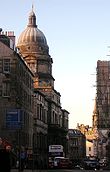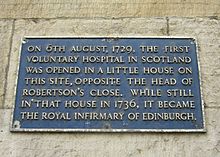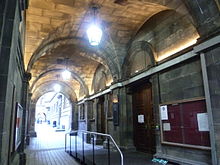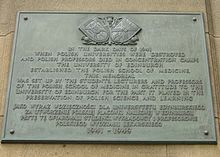- University of Edinburgh Medical School
-
Edinburgh School of Medicine Established 1726 Type Medical school Dean Prof Sir John Savill Admin. staff 1244 (2007/8; includes Support Staff) Students 2,218 (2007/8) Undergraduates 1,328 (2007/8) Postgraduates 890 (2007/8) Location Edinburgh, Scotland Campus The Medical School, Teviot Place; The Royal Infirmary Chancellors Building, Little France, The Western General; Royal Hospital for Sick Children Colours Dark Red, Light Red and Pale Yellow (or "Liver, Blood and Pus" according to the history books) Affiliations University of Edinburgh Website http://www.mvm.ed.ac.uk/ The University of Edinburgh Medical School is part of the College of Medicine and Veterinary Medicine of the University of Edinburgh. Established nearly 283 years ago, Edinburgh Medical School is one of the oldest medical schools in Scotland and the UK. It ranks first in Scotland and third in the UK (according to the Guardian University Guide in 2010[1] and The Times Good University Guide.[2]). It is ranked second in the UK by the independent Complete University Guide.
As of 2008 the school accepts some 218 British/EU medical students per year and an additional 16 students from overseas [3]. Admission to Edinburgh Medical School (MBChB Degree) is quite competitive, with over 85% of UK and EU applicants as well as 92% of international applicants being rejected every year[4].
Contents
History
Although the University of Edinburgh's Faculty of Medicine was not formally organised until 1726, medicine had been taught at Edinburgh since the beginning of the sixteenth century. Its formation was dependent on the incorporation of the Surgeons and Barber Surgeons, in 1505 and the foundation of the Royal College of Physicians of Edinburgh in 1681.
The University was modelled on the University of Bologna, but medical teaching was based on that of the sixteenth century University of Padua, and later on the University of Leiden (where most of the founders of the faculty had studied) in an attempt to attract foreign students, and maintain potential Scottish students in Scotland.
Since the Renaissance the primary facet of medical teaching here was anatomy and therefore in 1720, Alexander Monro was appointed Professor of Anatomy. Later his son and grandson (both of the same name) would hold the position, a reign of Professor Alexander Monros lasting 128 years. In subsequent years four further chairs completed the faculty allowing it to grant the qualification of Doctor of Medicine (MD) without the assistance of the Royal College of Physicians.
Success in the teaching of medicine and surgery through the eighteenth century was achieved thanks to the first teaching hospital, town physicians and the town guild of Barber Surgeons (later to become the Royal College of Surgeons of Edinburgh). By 1764 the number of medical students was so great that a new 200-seat Anatomy Theatre was built in the College Garden. Students were attracted to Edinburgh Medical School from Ireland, America and the Colonies by a succession of brilliant teachers, such as William Cullen, James Gregory and Joseph Black, the Medical Society and a flourishing Extra-Mural School.
The Royal Infirmary of Edinburgh
The origins of the Edinburgh Royal Infirmary began in a small house, opposite the head of Robertson's Close, in today's Infirmary Street. Only four beds were available from 6 August 1729 and medical students' visits were limited to two tickets only per student (to prevent crowding). This was clearly inadequate, and in 1741, shortly after the foundation of the college, a 228-bed purpose-built hospital was designed by William Adam. Due to overcrowding throughout this High School Yards site, David Bryce was commissioned to design a new hospital - the splendid Royal Infirmary of Edinburgh on Lauriston Place close to the university and next door to where the medical school buildings would be built in 1880.
In August 1998 a contract was signed to build a new Royal Infirmary at Little France, a replacement hospital on a mostly green field site in the south-east of the city. In May 2001 the original 20-acre (81,000 m2) Lauriston Place site was bought for £30 million by Southside Capital Ltd., a consortium comprising Taylor Woodrow, Kilmartin Property Group, and the Bank of Scotland. It is to be redeveloped as the Quartermile housing, shopping, leisure and hotel development.
The Royal Infirmary of Edinburgh is the oldest voluntary hospital in Scotland.
The Royal Botanic Garden of Edinburgh
The Edinburgh Botanic Garden was created in 1670 for study of medicinal plants by Dr Robert Sibbald (later first Professor of Medicine at Edinburgh University) and Dr Andrew Balfour. It gave a base for the development of study of Pharmacology (Materia Medica) and Chemistry. Originally at St Anne’s Yards adjacent to Holyrood Palace, the garden measured a meagre 40 square feet (3.7 m2). It moved subsequently to the ground now occupied by Waverley Station and in the 1760s was again relocated to Shrubhill between Edinburgh and Leith. It wasn't until after 1820 that the garden and its contents began the move to its present day location in Inverleith ('The Inverleith Garden') by Robert Graham (appointed Regius Keeper, 1820–45). It is currently recognised as the second oldest botanic garden in Britain after Oxford (OBG founded in 1620).
The nineteenth century saw a growth of new sciences at Edinburgh, notably of Physiology and Pathology, and the development of Public Health and Psychiatry. Midwifery was finally admitted as an essential part of the compulsory medical curriculum.
Women and Medical School
In 1869 Sophia Jex-Blake was reluctantly accepted to attend a limited number of classes in the School of Medicine, enrolling Edinburgh in the heated international battle for women to enter medicine. Full equality between the sexes was not achieved at Edinburgh Medical School until 20 years later. British medical schools openly refused to accept women students at this time. Jex-Blake persuaded Edinburgh University to allow not only herself, but also her friend, Edith Pechy, to attend medical lectures.
The Medical School at Teviot Place
In the 1860s the medical school was constrained within the Old College and by 1880 the new Royal Infirmary had been built on Lauriston Place. The construction of new medical buildings began and they were completed by 1888, in Teviot Place, adjacent to the Royal Infirmary. Together they housed the Medical Faculty with proper facilities for teaching, scientific research and practical laboratories. This complex came to be known as the "New Quad," in contrast to the Old College (sometimes known as the "Old Quad") and New College, which was not originally part of the university.
The competition to design the University's new buildings was won by the architect Sir Robert Rowand Anderson in 1877 (who later designed the dome of the Robert Adam/William Henry Playfair Old College building). After extensive European travel, he decided upon a 'Cinquecento' Italian Renaissance style which he judged "more suitable than Greek or Palladian, where the interior would have been constrained by the formal exterior, or mediaeval, which would have been out of keeping with the spirit of scientific medical enquiry".[citation needed] Initially the design incorporated a new University Graduation Hall, but as this was seen as too ambitious. A separate building was constructed for the purpose, the McEwan Hall, also designed by Anderson, after funds were made available by the brewer Sir William McEwan in 1894. The final grand structure took three years to decorate including elaborate ceiling murals and organ.
The Medical School was designed around two courts, with a grand public quadrangle at the front and, for discreet delivery of cadavers to the dissection rooms, a second private yard entered from the lane behind. The Professor of Anatomy, Sir William Turner (Professor 1867 to 1903, Principal 1903 to 1917) was placed in charge of the project leading to the construction of a three-storey galleried Anatomy Museum with displays of everything from whales to apes as well as human anatomy, an associated library and a whole series of dissecting rooms, laboratories, and a grand anatomy lecture theatre (based on that at Padua) with steeply raked benches rising above the central dissecting table. The Anatomy Museum has since been plastered and its remnants are now a student study space, off-limits to the general public, although the grand elephant skeletons that were once the hallmark of the museums entrance still remain in the east wing.
Today the medical buildings at Teviot Place focus on the teaching of pre-clinical subjects such as biochemistry and anatomy. The building still holds the anatomy teaching laboratory (although prosection has replaced dissection) and anatomy resource centre (a scaled down version of the anatomy museum) and the original lecture theatre. The building also hosts the Biomedical Teaching Organisation, where subjects allied to medicine (such as physiology and forensic science) are taught to senior biology students and to medical students taking intercalated degrees.
There are also currently plans to hand the West Wing of the medical school to the History Department of Edinburgh University, as the previous occupants (the Department of Medical Microbiology) have moved to the new campus at Little France.
The Medical School at Little France
The Chancellor's Building was opened on 12 August 2002 by The Duke of Edinburgh and houses the new £40 million Medical School at the New Royal Infirmary in Little France. It was a joint project between private finance, the local authorities and the University to create a large modern hospital, veterinary clinic and research institute and thus the University is currently (2003) in the process of moving its Veterinary and Medical Faculties there (and quite possibly also the School of Nursing). It has two large lecture theatres and a medical library. It is connected to the new Edinburgh Royal Infirmary by a series of corridors.
The Polish School of Medicine at the University of Edinburgh
The Polish School of Medicine was established in 1941 as a "a wartime testament to this spirit of enlightenment". Students were to be those drawn from the Polish army to Britain and were taught in Polish. Classes in pre-clinical subjects were held at the Medical School Clinical teaching was carried out mainly at the Royal Infirmary of Edinburgh in Lauriston Place. A separate building, the Paderewski Hospital, was built in the grounds of the Western General to provided care for members of the Polish armed forces and civilians[5].
The project was initiated by Lt. Col. Professor Francis Crew, then Commanding Officer at the Military Hospital in Edinburgh Castle, and Lt. Col. Dr Antoni Jurasz, the School's organiser and first Dean.
The school was closed in March 1949. 336 students matriculated of which 227 students graduated with the equivalent of an MBChB. A total of 19 doctors obtained a doctorate or MD. A bronze plaque commemorating the existence of the Polish School of Medicine is located in the Quadrangle of the Medical School in Teviot Place[5].
Admission
Gaining admission to study medicine at the University of Edinburgh is quite difficult with around 90% of applicants not offered a place.
Entry qualifications include:
SQA Highers: AAAAB. AAAAB at one sitting to include Chemistry and two of Biology, Maths or Physics. Students unable to take two of Biology, Maths, Physics in S5 may take the missing subject(s) in S6. Human Biology may replace Biology. Standard Grade Credit (or Intermediate 2) in Biology, Chemistry, English, Maths.
GCE A Levels: AAA. AAA plus grade B at AS-level. A levels must include Chemistry and one of Biology, Maths or Physics. Biology at AS level required as minimum. Only one of Maths or Further Maths will be considered. Human Biology may replace Biology. GCSE grade B in Biology, Chemistry, English, Maths. Double Award Combined Sciences at grade BB may replace GCSE grades in sciences.
Additional requirements include the UK Clinical Aptitude Test (UKCAT) is a mandatory requirement for all students applying to study Medicine at Edinburgh and applicants are required to sit the test during the summer prior to application. Registration for the test is via the UKCAT website.
Most applicants including overseas applicants are not interviewed prior to admission[6].
The 5 year MBChB course can extend a pre-entry year for applicants without adequate subject choice but with the right qualifications who otherwise would be admitted on to the 5 year programme, or an extra 'intercalated year' between years 2 and 3 to gain a BSc or BMedSci in a separate scientific discipline.
The Current Course and Curriculum
Degrees available for study: Medical Sciences (BSc), Medicine (5-year course) (MBChB) with optional intercalated Medical Sciences (BMedSci).
MBChB: Years 1 & 2
Students undertake the study of Biomedical Science and Health and Society, which provide an introduction to the scientific, sociological and behavioural principles for the practice of medicine. Practical clinical and resuscitation skills are also taught. Contact is made with patients and their families in Talking with Families and Health Needs of Older People and will have the opportunity to work in a clinical setting and investigate a chosen healthcare issue.
In year 2, students undertake basic history-taking and examination in teaching general practices.
Intercalated year
This optional year achieves the student an intercalated Bachelor of Medical Sciences honours degree. 18 fields of scientific study are available and covered in great depth.
Years 3 & 4
Clinical attachments are undertaken, and an understanding of clinical medicine is taught. Bedside teaching is enhanced with lectures and opportunities are made available to students within the Royal Infirmary.
Year 5
Recovers all the topics of year's 1-4 and includes an elective period of eight weeks, when many students broaden their clinical experience by studying overseas.
Facilities
Undergraduate teaching through year 1 and 2 center mainly in the Medical School buildings on Teviot Row in the university quarter of Edinburgh city centre. Clinical years, 3, 4 and 5 are spent spread across the three main teaching hospitals in Edinburgh, the Royal Infirmary of Edinburgh (RIE) in Little France, in the city's southern Green Belt; the Western General Hospital just west of the city centre, and the Royal Hospital for Sick Children in the centre of the city.
The Royal Infirmary of Edinburgh is the main clinical teaching environment of the Medical School. The Chancellor's Building at Little France, next to the new Royal Infirmary was opened on 12 August 2002 by HRH Prince Phillip Duke of Edinburgh, Chancellor to the University.
- The Biological Sciences and Hospital-based Clinical Subjects both gained a 5 rating.
- Only two other UK undergraduate medical schools also achieved a 5 rating in Hospital-based Clinical Subjects
- Plan of the Chancellor's Building - Little France
- Location of major medical buildings
EEMeC
Edinburgh Electronic Medical Curriculum is an online virtual learning environment (VLE) which allows students securely protected access direct to any of the information on or for the MBChB course. It also encompasses announcements, discussions and the use the tools embedded in EEMeC to facilitate and manage students' progress through the course including exam results and computer aided learning programmes. Created in 1998 this was one of the first of its kind in the world and has since provided a model for other medical schools to follow. In 2005 The University of Edinburgh was awarded a Queen's Anniversary Prize for EEMeC and The Virtual Hospital Online.
Research
Edinburgh University is a member of the Russell Group of universities, receiving a quanta of a third of British research funding. In the last UK-wide Research Assessment Exercise, three quarters of the College's research staff were in academic units rated 5 or 5 star (the maximum possible ratings). This was more noteworthy in view of the large size of the College's research groupings. The College has average research income in excess of £45 million/annum, and the figure has been steadily increasing each year.
Main sources of research funding include UK research councils, UK medical and veterinary medical charities, industry and commerce and European Union bodies.
Royal Medical Society
The Royal Medical Society, the medical society at the University of Edinburgh is the oldest Medical Society in the UK. Known originally as 'the Medical Society' from 1734 it became known as 'the Royal Medical Society' from 1777. It has its own premises and a fine library built up throughout the 18th and 19th centuries, unfortunately sold at 3 sales at Sotheby's London in 1969. Much of the collection was purchased by the University of Wisconsin–Madison.
Famous alumni
- Sir Thomas Lauder Brunton, 1st Baronet FRS - discovered organic nitrates had the ability to alleviate angina pectoris.
- Sir George Beatson - surgical oncologist who pioneered treatment of breast cancer.
- Joseph Black - discoverer of carbon dioxide and of latent heat.
- William Cullen - First Physician to the King in Scotland.
- Arthur Ignatius Conan Doyle - novelist.
- John Crofton - respiratory physician and public health pioneer.
- Erasmus Darwin – physician, poet, author and evolutionary biologist.
- Charles Darwin - briefly studied medicine at Edinburgh.
- John Fothergill (1712–1780), English physician, plant collector, philanthropist
- James Gregory - President of the Royal College of Physicians of Edinburgh and author.
- William Jardine - co-founded the Hong Kong conglomerate Jardine, Matheson and Company.
- Sophia Jex-Blake - the first woman to study medicine at Edinburgh.
- Joseph Lister - the first to practise antiseptic surgery in the 1870s ("the father of modern antisepsis"), Professor of Surgery 1870-77.
- Robert Liston - pioneering Scottish surgeon.
- Sir James Young Simpson - discovered chloroform anaesthesia in 1847, revolutionising obstetric and surgical practice.
- James Syme - pioneering Scottish surgeon.
- John Batty Tuke - pioneering neuroscientist.
- William Withering - botanist and physician, discovered Digoxin.
Doctors Pub
Situated directly across the road from the medical school buildings and the old Royal Infirmary, "Doctors" has been the refuge since the 1970s of many Edinburgh Medical School graduates and students. History drapes the walls in the forms of plaques and photographs.[7].
References
- ^ "University guide 2010: Medicine". The Guardian (London). 2009-05-12. http://www.guardian.co.uk/education/table/2009/may/12/university-guide-medicine. Retrieved 2010-05-27.
- ^ Watson, Roland; Elliott, Francis; Foster, Patrick. "Good University Guide 2010". The Times (London). http://extras.timesonline.co.uk/tol_gug/gooduniversityguide.php?AC_sub=Medicine&x=13&y=14&sub=44.
- ^ "www.ukmedicalschools.com UK Medical School Statistics". ukmedicalschools.com. http://www.ukmedicalschools.com/index.php?pageid=stats. Retrieved 2008-09-08.[dead link]
- ^ "The Selection Process". http://www.mvm.ed.ac.uk/studying/admissions/applying/selection.htm#process. Retrieved 2009-03-01.
- ^ a b "The Polish School of Medicine at the University of Edinburgh". http://www.mvm.ed.ac.uk/polish_school/index.htm. Retrieved 2009-03-02.
- ^ http://www.mvm.ed.ac.uk/studying/admissions/MBChB%20Applications%20FAQ.pdf
- ^ "Edinburgh Doctors". http://www.beerintheevening.com/pubs/s/10/10758/Doctors/Edinburgh. Retrieved 2009-03-01.
Further reading
Matthew Kaufman, Medical Teaching in Edinburgh during the 18th and 19th Centuries (Edinburgh, the Royal College of Surgeons of Edinburgh, 2003), ISBN 0950362085 [1]
Tara Womersley, Dorothy H Crawford, Bodysnatchers to Lifesavers: Three Centuries of Medicine in Edinburgh (Luath Press Ltd, Edinburgh, 2010), ISBN-13: 978-1906817589
External links
- The Royal College of Surgeons, Edinburgh
- The Royal College of Physicians, Edinburgh
- Sophia Jex-Blake
- Admission FAQ's

History Academic
DivisionsCollege of Humanities
and Social ScienceESALA · Business School · School of Economics · New College, Edinburgh (School of Divinity) · School of Law · School of Literatures, Languages and Cultures · School of Philosophy, Psychology and Language Sciences ·
Moray House School of EducationSchool of Biomedical Sciences · School of Clinical Sciences and Community Health · School of Molecular and Clinical Medicine ·
Royal (Dick) School of Veterinary StudiesSchool of Biological Sciences · School of Chemistry · School of GeoSciences · School of Engineering · School of Informatics · School of Mathematics ·
School of Physics and AstronomyFacilities Students Students' Association · Sports Union · Association Football Club · Boat Club · Body Snatchers · Children's Holiday Venture · Edinburgh University RFC · Fresh Air · The Journal · Meadows Marathon · Music Society · Plinian Society · Potterrow Student Centre · Royal Medical Society · Student (newspaper) ·
Teviot Row House Medical schools in the United Kingdom
Medical schools in the United KingdomEngland LondonBarts and The London School of Medicine and Dentistry · Imperial College School of Medicine · King's College London School of Medicine · St George's, University of London · UCL Medical SchoolMidlandsNorthSouthNorthern Ireland Scotland University of Aberdeen, School of Medicine · Bute Medical School2 · Dundee Medical School · University of Edinburgh Medical School · University of Glasgow Medical SchoolWales 1In conjunction with Newcastle, 2 year pre-clinical course only 2Part of the University of St Andrews, pre-clinical course only
 Category
CategoryCoordinates: 55°55′19.42″N 3°8′11.86″W / 55.9220611°N 3.1366278°W
Categories:- University of Edinburgh
- Education in Edinburgh
- Schools of medicine in Scotland
- Health in Edinburgh
- Robert Rowand Anderson buildings
Wikimedia Foundation. 2010.







